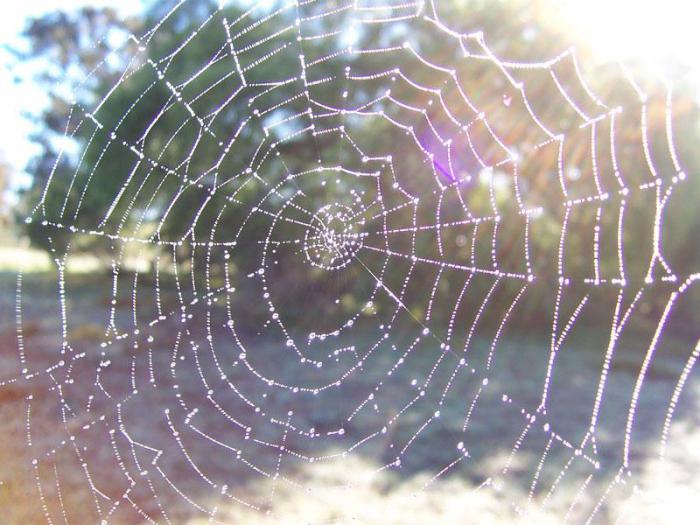Volcano Avachinsky (Avachinsky Sopka, Avacha, Avachinsky Volcano, Avacha Volcano, Avachinskaya Sopka)
Sopka Avachinskaya is now an active Far Eastern volcano. It is located in the southern segment of the Eastern Ridge, between the rivers Nalycheva and Avacha. This geological formation is of the Somma-Vesuvius type. The double structure is a relatively young cone embedded in the older one. In the south of Sopka lies Petropavlovsk-Kamchatsky.
The height of the Avachinsky volcano is 2741 meters above the sea level. The apical cone consists of basalts and andesites, tuff and slag deposits. Inside the 400-meter crater there are many fumaroles. After the eruption in 1991, the volcano's vent turned out to be blocked by a voluminous lava plug. At the top of Avacha is a dozen glaciers, covering an area of 10.2 km².
The lower part of the volcanic slope is covered by typical tundra vegetation - dwarf birch and coniferous elfin. The upper one is hidden by glacial masses and perennial snow (firn). The northern ice sheet is named after Arsenyev. The profile monitoring station of the Russian Academy of Sciences is located at the Avachi base.
Avachinskaya Sopka is extremely popular. The explanation for this is an uncomplicated rise and close location in relation to the capital of the peninsula. A pedestrian path leads to the top of the volcano. The duration of the ascent is about 6-8 hours. To date, this route is very in demand. Every year thousands of tourists come to the crater.
External outlines Avacha formed as a result of the catastrophic eruption of the previous stratovolcano 11 thousand years ago. Its height was 4,500 m. The event took place in the late Pleistocene. Later, there was a rise of a new cone, and a soma with a diameter of 20 km was formed. This geological structure is altogether different - from 2,100 m to 2,300 m.
In the middle Holocene, a new event took place - the most powerful release of rocks. Their volume was 12 km³. From the southwest, the Somma received faults, and the segment of the mountain between them dropped to 400-500 m. Mount Saray and Mount Monastery formed. The growth of the volcanic cone began 5 thousand years ago (late Holocene). At the moment, its height is about 700 m.
On Avachinskaya Sopka, there were multiple eruptions. They were fixed 18 times at different frequencies, beginning in 1737. The last eruption took place in 1991.
Active ascents to Avacha began in the XVIII century. At the same time it was first documented. The French expedition of La Perouse, which included Bernie, Resver and Monge, attempted to ascend in 1787. 37 years later, in 1824, Otto Yevstafievich Kotsebu's group made a successful journey to the summit. The navigators explored the crater and brought trophies to the vessel-the crystals of volcanic sulfur.
(Avacha), Avachinsky , Avach Mountain , Burnt Hill - active volcano on Kamchatka , in the southern part East Ridge , north of Petropavlovsk-Kamchatsky , in the interfluve of rivers Avacha and Nalycheva . Refers to volcanoes of the type Somme -Vesuvius.
General information
The height is 2741 m, the peak is conical. The cone is composed of basaltic and andesite lavas, tuffs and slag . The diameter of the crater is 400 m, there are numerous fumaroles . As a result of the eruption, which occurred in 1991, a massive lava plug formed in the crater of the volcano. In the apical part of the volcano (together with the volcano Kozelsky) there are ten glaciers on an area of 10.2 km².
The lower slopes of the volcano are covered with forests from cedar wood and stone birch , in the upper part - glaciers and snow. The glacier on the northern slope is named in honor of the Far Eastern researcher Arsenyev.
At the foot of the volcano there is a volcanological station.
The first study and description of the volcano performed S.P. Krasheninnikov in the 1730s.
History of the formation of the volcano
The characteristic shape of the volcano is caused by a catastrophic eruption stratovolcano (Paleo-Avacha) with a height of more than 4,500 m, which occurred about 11,000 years ago (late pleistocene), with the subsequent build-up of a new cone (Kayno-Avacha). The diameter of the formed volcano somma is 20 kilometers, and its height in different places reaches 2100-2300 meters. As a result of a powerful explosion that occurred on average holocene , in the valley of the Avacha River, 12 km³ of rock was thrown out, and from the southwest side radial somma faults were formed. Part of the somma, concluded between the faults that formed, later fell to 400-500 meters - now this part of the volcano is represented by the Mount Monastery and the Saray. The cone of the volcano began to grow about 5000 years ago (in the late Holocene). At the moment, the relative height of the cone is about 700 meters.
The documented volcanic eruptions occurred in 1737, 1772, 1779, 1789, 1827, 1837, 1855, 1878, 1771, 1894, 1895, 1901, 1909, 1926, 1927, 1938, 1945, 1991.
Ascension to the volcano
Avachinskaya Sopka is one of the most frequented volcanoes in Kamchatka. This is due to the relative availability of the volcano, its proximity to the capital The Kamchatka Territory - Petropavlovsk-Kamchatsky and the ease of recovery. On the top of the volcano a path is laid, the average time of ascent to the volcano is from 6 to 8 hours. In the summer, climbing does not require special training or equipment.
The history of documented ascent to the Avachinsky volcano begins in the XVIII century, but the mass character of the ascent began to be acquired only beginning in the 90s of the twentieth century. At the present time, an annual mass ascent of the volcano takes place, in which thousands of tourists take part. Below are some historical facts concerning the ascent to the Avachinsky volcano.
Cinema
- The documentary film "Avachinsky Volcano", 1979, directed by V. Shishkov.
Volcano Avachinsky heads the Avacha group of volcanoes, which includes Aag, Arik, Koryaksky , Avachinsky and Kozelsky volcanoes, they refer to the so-called "home" volcanoes of Kamchatka. From Petropavlovsk-Kamchatsky to the foot of the Avachinsky hillock, only about 25 km to the northeast. The volcano is a young cone, towering over the surrounding "collar" - the remains of an old cone, destroyed by a volcanic explosion about 11 thousand years ago. Avacha's height is 2749 meters above sea level.
Avachinskaya volcano is an active volcano, in its crater there are powerful fumaroles, and even from afar it is visible as Avacha "smokes". Its eruptions have been observed since 1737, on average the volcano erupts every 15 years. The last eruption was in 1991, as a result of which a massive cork of frozen lava formed in the crater.
The ascent to the Avachinsky volcano takes place all year round, but, of course, in summer it is incomparably greater than in the cold season. You can drive up to the foot of the volcano in the summer on an off-road car on the Dry River from the side of the city of Elizovo. The road ends at Avachinsky Pass, where there are camp sites with houses and a bath.
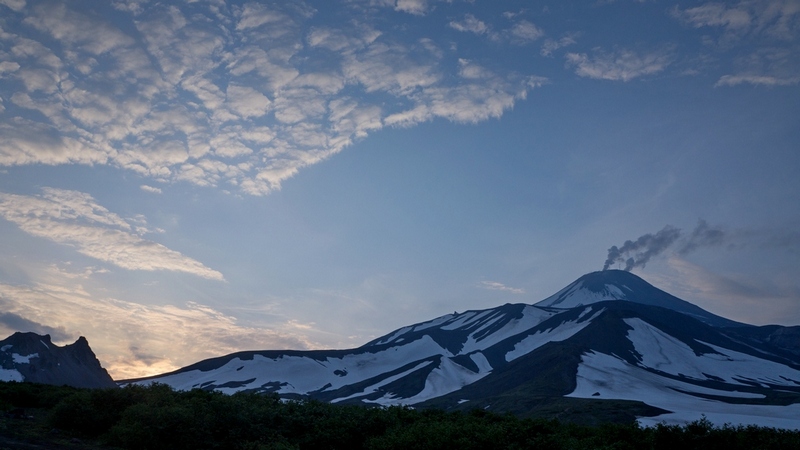
The route of ascent begins on the crest of the soms of the ancient destroyed cone, then the path goes to the young cone. The steepness of the climb is quite large, so the path winds with serpentine, and at the last 50 meters the rope is stretched out as a handrail. By the time the ascent can take from 5 to 9 hours, the height difference at the same time is 1900 meters, which is quite a lot by climbing standards. Nevertheless, the children and the elderly are rising on the volcano, if health allows, because the main desire and aspiration to the goal, and technical skills of mountaineering are completely unnecessary, especially if accompanied by an experienced guide. At the end of the path, there is a crater 400 m in diameter, powerful fumaroles and extensive panoramas to the cities of Petropavlovsk and Elizovo, neighboring volcanoes, Avacha Bay and the Pacific Ocean. In the crater, you can always hide from the wind and warm yourself on warm ground.
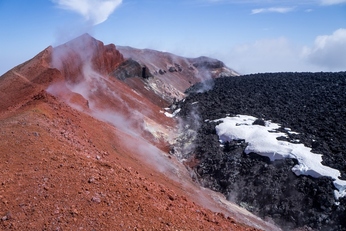

In winter, camp sites for a volcano come on snowmobiles. Travel agencies organize skiing and snowboarding here. Also in winter, often climb to Avacha on the other side - from the outskirts of Petropavlovsk-Kamchatsky and practically to the southern foot of the Avachinsky hill is the Skiing of Health. But at this time of year it is necessary to have cats and an ice ax, a winter climb to the Avachinsky volcano - this is already a 1B difficulty category in the alpinist classification of routes. It's especially cool to take a walk on the slopes of Avacha in the spring in April, when it's already warm enough, but the snow is not falling yet. The bright spring sun, reflected from white snow, perfectly warms and leaves the most resistant snow tan on the body.
Ascent to the volcano Avachinsky
30 kilometers north of the city of Petropavlovsk-Kamchatsky there is the Avacha group of volcanoes. It includes two active volcanoes and three extinct ones. Because of their proximity to the city, they are very popular, and the gray towns on their background look very mysterious. I'm not a trained alpinist, but I climbed these volcanoes on my own.
Let's see how this can be done, but consider that in the mountains, even on not the most difficult ascents, it can be really dangerous. Assess your strength and strength of your companions.
How to climb the Avachinsky volcano yourself
Volcano Avachinsky (2741 m). The current, last eruption in 1991.
The time of ascent to the Avachinsky volcano is 6-8 hours, the time of descent is 3-4 hours.
If you get to it yourself, you need to get from the city of Petropavlovsk-Kamchatsky to the bus to the city of Elizovo (40 rubles), get to the stop of the 25th kilometer, there to go on the track with the name "At 25 km" and catch the car before turning on Avachinsky (all local people know it, it's good hitchhiking, it's no more than five kilometers to go).
Next you need to overcome 16 kilometers along the bed of the Dry Handle, with a small set of heights. If this is July or August, you are most likely to be driven by a car, because the flow is very large. People with children, animals and simply from idleness go to volcanoes. Either mushroom pickers and berry pickers will take you some of the way and tell local tales about bears.
By the way, I highly recommend one of the first things to buy a falshfeyer (signal checker). With him, of course, you are not 100% protected from bears, but you will feel psychologically more confident. Although I, frankly, confined myself to a positive reserve, and the bears I saw only from the bus.
If you go to a non-season, then perhaps this way you have to overcome on foot (we spend 3 hours on it). There is nowhere to turn out, the huge landmark is the volcano, which will always be in front of you, so you'll come straight to the base camp.
You need to go through the base, register well with the MOE if you plan to climb (it's free), along the path go to the river, cross it over the rocks, and you will go to the place where you can camp. In the birch and alder, you can find a very small amount of wood (with this problem), and partly hide from the wind. They live greyhound greyhounds (such as gophers with long tails), curious foxes who stole our shoes, and many berry meadows with blueberries, honeysuckle, siksha, cowberry, and kalina.
Ascent is better to start at 6 - 7 am, because by lunchtime the cone of the volcano often tightens the clouds, which stay on it until the evening. You leave the camp in the direction of the volcano, crossing the deep crevice of the Dry River. The path there is pronounced, up to the very crater. This volcano is beautiful with its simplicity (in good weather), along with a decent height and incredible views.
You can see the itinerary in the photo:

At an altitude of 2000 m there is an iron box (telemetry point of the Institute of Volcanology), where it is convenient to make a long halt, have a snack and gain strength before a long climb (30-35 °).
The rock of the volcanic rock is very small and loose, so choose the appropriate footwear.
Before the eruption in 1991, the crater of the volcano was 220 meters deep and 350 meters in diameter, during the eruption the funnel was almost completely filled with lava, and even over the edge a little poured out. Therefore, now the deepening in the crater is not great, but interesting. Stone rock is red, and fumaroles that go as a rule with two streams add this unearthly view to this landscape.
The volcano periodically shakes and it makes dull buzzing sounds, someday it will burst out again :)
It is better to descend better and group along another path, since the stone is very loose, but if the snow has already fallen or is frozen, then the path of ascent is quite suitable for descent. On a volcano, as in the mountains, no one guarantees 100% security, be careful, and stick together.
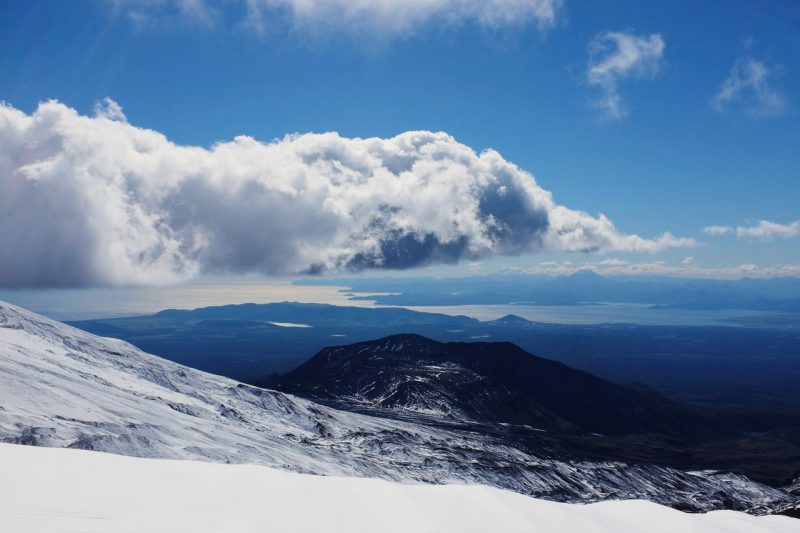 A view of the city from Avachinsky volcano
A view of the city from Avachinsky volcano If you want to simplify your life, then you can take an excursion to the Avachinsky volcano. For this, you dial the "Excursion to the Avachinsky Volcano" on the Internet and find the one that you like more. The support will be from five thousand rubles per person, usually with one overnight stay either in tents or at a recreation center. Sleeping gear and other equipment can be rented. You will be fed and everything will be told and shown.
 Campground at the foot of volcanoes
Campground at the foot of volcanoes How to climb the volcano Koryaksky
Koryaksky volcano (3456 m., The highest south of Kamchatka). It is considered a complex category volcano, tourists do not drive here.
But if you consider yourself prepared for the difficulties and a sporty person, you can climb to the top of this volcano (there is incredibly beautiful).
 The path along the river to the Koryak volcano
The path along the river to the Koryak volcano The simplest way of it is category 1B, for this you need to get out of the camp (the same as for Avachinsky volcano), and go along the river in the direction of a wide corridor. Keep to the left side until you reach the ridge separating the couloir. Again, sticking to the left side, walk along the narrow couloir until you reach the crest.
The whole ascent is carried out along the ridge, on the right in the half-step there is a steep deep precipice, to the left there are the stone jungles, smoothly leaving for the precipice.
Moving along the couloir looks more adequate, but in fact it is dangerous because of frequent rock falls in the summer and avalanches in winter.
The whole insidiousness of this volcano is that the top can not be seen right away, and crawling to the point that you considered the top, you are given a new view of the distant imaginary peak, and so many hours in a row.
After a little more than half way you will reach the 45 ° rise, breaking it will lead to the stone gate. Upon reaching this site you will need cats and ice axes.
We instead had only positive, but please be extremely cautious, the people here were killed a lot.
Through the gate exit to the pre-tip area, move along which you need in bundles of traverse. The last 10 m before the summit are realized through a steep ascent between the rocks. That's the top! There is no crater here, but there are plenty of space.
And now the most difficult part of the program is descent.
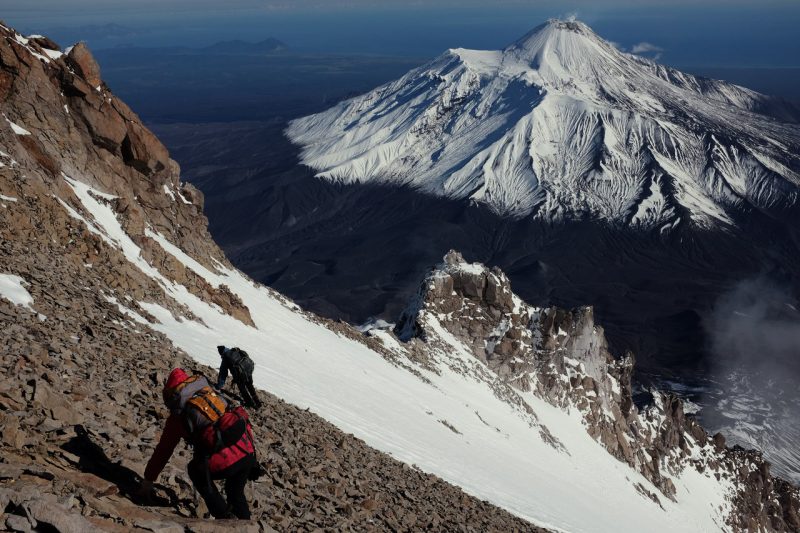 Descent from the volcano Koryaksky
Descent from the volcano Koryaksky The whole volcano is made of pop, on top is a small stone, to the bottom is a large one. The path is clearly pronounced, as it is a crest, the main thing when descending is to go to the same crest where they rose, they periodically separate.
💡 Hike to the volcano takes all day if you go out no later than five in the morning You have a chance to return to the camp before dark (hours to seven). In the mountains it is very important - do not try fate and go back in the dark.
💡 The climb is 2.5 kilometers, assess your physical abilities adequately, look closely at what kind of people go with you, this is important.
A few words about our team and planning for ascents
There were three of us: a Russian guy who has lived in New Zealand for the last years, and a Russian guy who was born in Latvia, lived in France, and now just travels like. When we camped at the foot, we discussed for a long time on which volcano to go, it was too much for both of us. Initially, we had two more: an American woman who lives in Spain and Wilson from Hong Kong.
We agreed on the opinion that if we go to Koryaksky, then the next day we will definitely not be able to move where ever ... Therefore, we went the first day to Avachinsky. There was bad weather, and, frankly, it was my most difficult climbing anywhere. The weather was extremely unfavorable, the wind blew from the feet at the foot, and to the crater there was zero visibility and the absence of a trail. Only three of us came to the crater: I and two of the guys described above.
After descending, we announced the fact that tomorrow at 5 am we go up to Koryaksky, what we just wished good luck and no one showed a desire to come with us. We woke up and, actually, went. Up to the middle of the road, it all seemed like a bad idea, but as soon as we saw what kinds of things are opening up to us and what the weather ... sleepy and tired state passed automatically, common interest and super-abilities awoke.
Cool, when such a team spirit is born in a team with unfamiliar people.
Volcano Avachinsky (Avachinskaya Sopka , Avacha , Avachinsky Volcano , Avacha Volcano , Avachinskaya Sopka ) is located to the north-west of . The volcano enters the chain of five volcanoes of the northwest strike. Located 27-30 km to the north-east of cities Petropavlovsk-Kamchatsky and Elizovo, 55 km from cities Vilyuchinsk. The volcano has a complex construction of the Somma-Vesuvius type, only considerably larger. Somme has a diameter of more than 4 km. It is destroyed and is open in the south-western part. In the eastern, undisturbed part, the absolute height of its edge is 2317 m. The atrio between the remaining edges and the modern cone is filled with ice and firn, which several languages descend to the slopes of the volcano. The modern cone is asymmetrical in the som. It has the correct form, its absolute height is 2751 m, relative 400-1000 m. The top is crowned by a crater. Until 1991, it had the shape of a funnel with a diameter of 350 m and a depth of 220 m. In 1991, during the eruption, the funnel was almost completely filled with lava. A small stream of lava poured into the southern slope of the cone. In general, the surface of the cone is flat and only in the apical part is complicated by a heap of last eruptions.
The eruption of the Avachinsky volcano
January 1991
Archive of AP Piragis
www.piragis.ru
The cone is composed of basalts, andesite-basalts. Somme is composed of two lava-pyroclastic complexes of rocks: ancient basaltic and comparatively young - andesite and andesite-basalt composition. Numerous streams of pyroclastic and explosive formations form the lower parts and foot of the volcano in the southwestern and northern sectors.
The beginning of the formation of the volcano refers to the upper, possibly, Middle Pleistocene, the second stage of activity being characterized by powerful directional explosions that destroyed the southwestern part of the caldera. Fragments of it are fixed in the remains monastery and other entities. Then a rather strong extrusive and explosive activity began, as a result of which a volcano formed Meso-Avacha. Outbreaks of activity with long periods of rest were observed 18, 11-10 thousand years ago. The last phase of eruptions and the formation of a modern cone began 3,5-3 thousand years ago and continues to the present time.
Judging by the nature of the tephra deposits, at first there were 100-year breaks after eruptions, and in the last 250 years there were 13 eruptions. The penultimate was observed in 1945, the last was in 1991. On January 13, two rather violent explosions occurred in the summit crater. Then his cavity began to fill with lava. After full filling of the crater cavity, a small lava flow was poured onto the southern slopes of the cone, the front of which reached a glacier located in the atrio somma in its southwestern part, active fumaroles operated between the eruptions at the bottom and walls of the crater. The temperature of the gases at the outlet varied from 50 ° C to 185 ° C, the highest at its bottom.
Currently, fumaroles are confined to different parts of the lava that flooded the crater. The most powerful outlets are observed in the vertex part. Here and in many other areas, the lava surface subsides as a result of compaction of the material due to its heating. In this regard, it is not recommended to move people on the top surface without special equipment and consultations of volcanologists.
Until recently Avachinsky volcano was among the most active in Kamchatka. It arose several tens of thousands of years ago, and its right cone rose higher . But giant explosions demolished its upper part and formed a caldera with a diameter of almost 4 km. About 5 thousand years ago a new cone began to rise from the bottom of the caldera. In its modern structure Avacha refers to the type of double volcanoes.
The explosion of the volcano was directed to the south-west. The hot clouds of gases, ash, small and large fragments rushed to the side Avachinskaya Bay and, flying about 25 km, almost reached its shores. Deposits of clouds covered the ground with an uneven layer up to 300 m thick. All hilly plateau to the north of Petropavlovsk was created by these deposits. In the hollows lie lakes Sinichkino , Flat, Passerine and a number of others.
Over the last century, eruptions occurred in 1901, 1909-1910, 1926-1927, 1938 and 1945. Thus, during this time, the average period between eruptions was 9-10 years, and the largest one - 16 years. Since the last eruption, more than 40 years have passed (the book was published in 1988 and was written before the eruption of the Avachinsky hill in 1991. - Note. Ed. site), the volcano is silent, limited to moderate fumarolic activity. Some volcanologists believe that this protracted period of rest may last many tens, if not hundreds of years, others believe that the probability of an eruption before 1994 will be 65%.
The last eruption occurred on February 25, 1945 (the book was published in 1988 and was written before the eruption of the Avachinsky hill in 1991. - Note. Ed. site). In the days that preceded it, from the crater, as usual, the column of vapor rose steadily, and nothing foreshadowed changes in the behavior of the volcano. A small group of three people, which included the author ( Vladimir Semenov. — Note. ed site), was preparing on the last Sunday of February to rise on Avachu . Due to minor, non-climbing reasons, we postponed it. And the eruption started, fortunately, we had to observe from Petropavlovsk. That Sunday, around 2 pm, light gray clubs poured from the crater. Their color quickly darkened, the height increased. The swirling ash column rose to a height of 7-8 km. On the southern slope, the proposed track of our ascent, the gray shafts of gases and ash rolled down, white clouds from the evaporated snow rose through them. A ash cloud in all directions was cut by lightning. By the evening, volcanic bombs were being seen, they were being thrown out at a kilometer-high by volleys. From the volcano came a softening, sometimes amplifying, rumble. AT Petropavlovsk The earth trembled, the dishes rang on the tables, the window panes rattled.
North-west wind ash column bent and, forming a dark plume, slowly swept towards the ocean. The layer of fallen ash in the zone of ash falls to half a meter. Birch forests and bushes were lost. The roads were covered, and they had to be cleaned. The shafts and heaps of slag along the roads reminded the situation during the snow drifts. There were also casual victims. Slag later found the widest application - all buildings in Petropavlovsk and the surrounding area are built using this light material.
Crater Avacha an irregularly shaped, irregularly shaped funnel of about 400 m in diameter and about 250 m deep at the top. From the crevices in the walls and at the bottom of the crater, streaming jets of vapors and gases burst. The temperature of the lateral fumaroles reaches 150 ° C, the bottom temperatures reach 500-600 ° C. In places where they exit, the walls are painted in yellow and whitish tones with deposits of sulfur, ammonia and other substances.
The depth of the crater is unstable. So, after the lava eruption of 1938, the cork of cooled lava stopped at a depth of only 30-40 m from the upper edge, and descent to the bottom was easy and safe. With a purely ash eruption of 1945, the old cork was discarded, and the crater became much deeper, and the descent into it is complex and dangerous. It is noteworthy that the group of schoolchildren was the first to descend into it in July 1956. No equipment, no experience they had, and the risk was huge. Since then occasional sporting descents have been repeated and volcanoes are often descending, of course, provided with both equipment and oxygen devices.
Climb to the top Avacha technically simple, but caution and discipline are mandatory, and non-compliance has led to several human casualties. The most tragic case is yet to be told. July 20, 1968 the weather for the ascent was clearly unfavorable - a strong wind blew, the summit was covered with clouds. But, despite this, without knowing the route of ascent, nor the conditions of ascent, the Leningrad geologist S. G. Kotlyar and his daughter Natasha, a fifth-year student of the university, went on an ascent. They had ice axes, the geologist had to have experience too. But the snow-covered surface of the cone was icy, and there were no cats or otrikonnennyh shoes. It was necessary to return, but they continued to rise. Somewhere along the way, and perhaps already at the edge of the crater, one of them slipped and began to move, another rushed to the rescue and also fell. They did not manage to stay with ice axes. They found them only after two days at the foot of the cone, broken and frozen.



